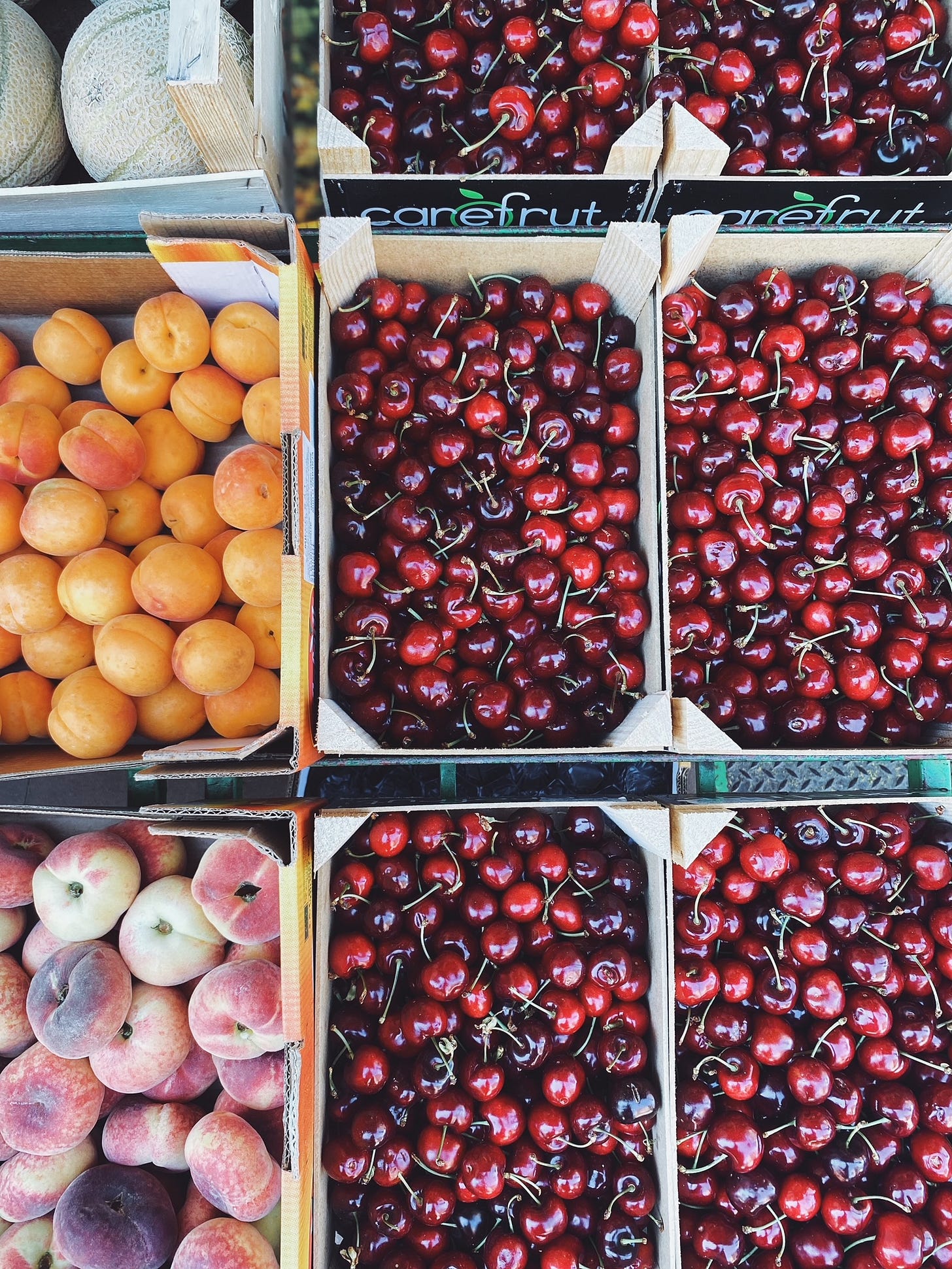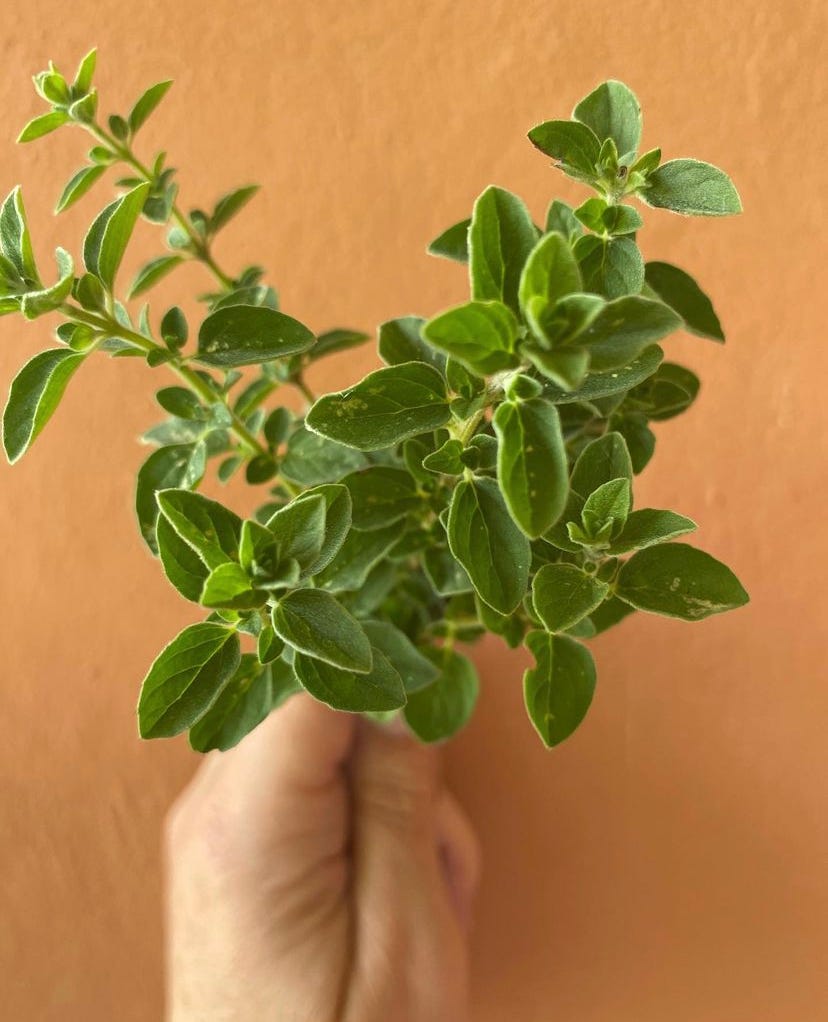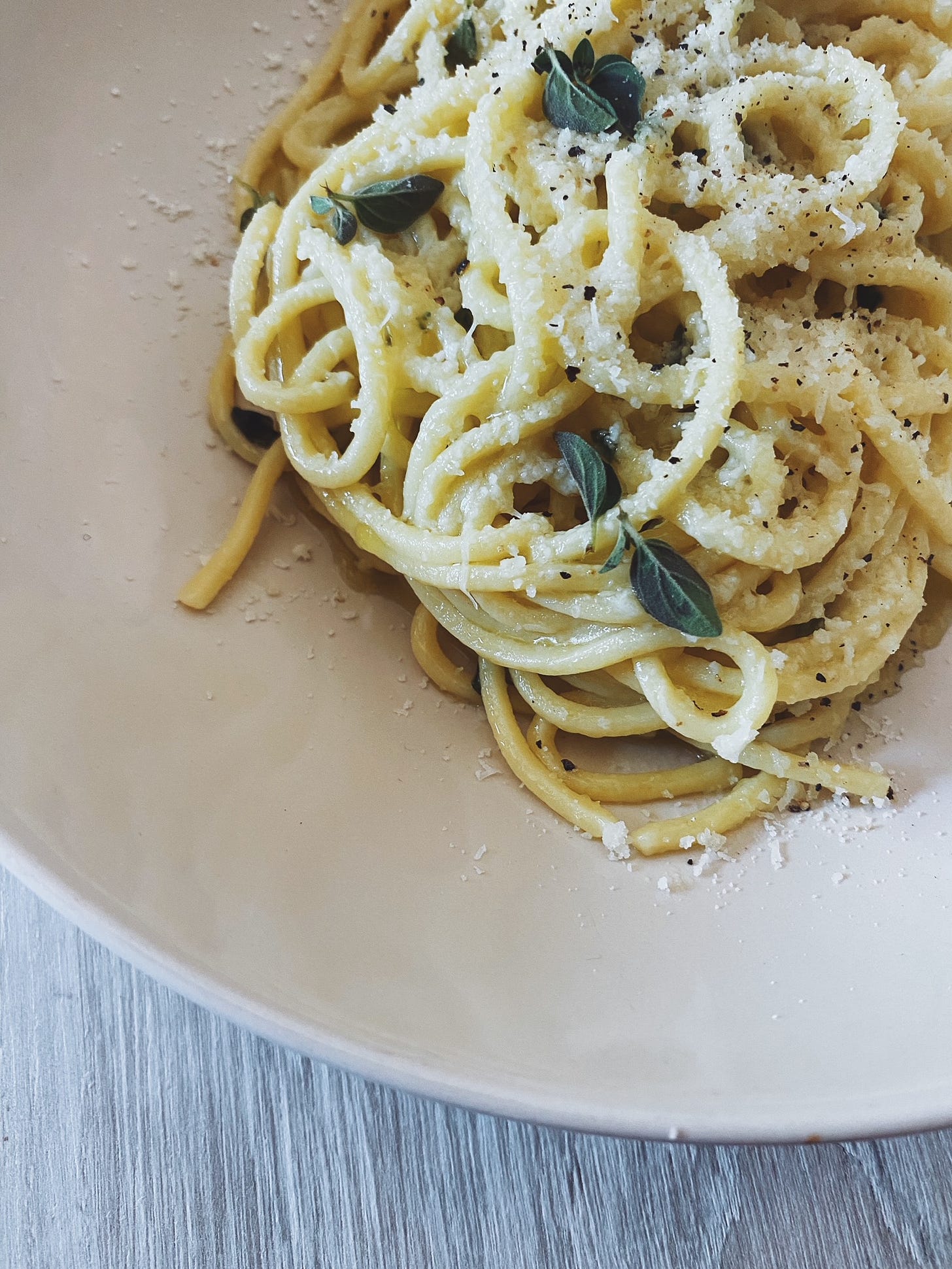A Delicate Dish of Tagliolini, Marjoram and Pecorino
The Essential Aromatic Herb That You May Not Be Using and Let's Stay Focused

This recipe was originally 4 ingredients until it wasn’t anymore.
You see I was called to visit a bustling area of Rieti whose streets hold the administrative offices and a good number of retro mom-and-pop shops which together with the perfect late spring weather made for a good reason to wander. When I passed the colourful produce stand on the corner, the one with the red and white striped awning, it was also hard not to admire the gloss of the season’s first cherries, the matt fuzz of the blushing apricots and the fresh green peas that sat beside them. I had been seduced by the skinny organic asparagus sitting next to the scale of our village supermarket the night before and I thought that both the peas and the asparagus would make a great addition to the dish of tagliolini, marjoram and pecorino which was my lunch time’s desire.
So I walked off with a brown paper bag full of pods delighted with my find as pea season in these parts is now passing us and I knew that I might not see them again. I went home to find that I only had tagliatelle to hand and I thought they would do. When all was said and done, the plate that I had before me albeit bursting with seasonal flavour had completely changed shape, and lacked the delicious simplicity of my original want and thus this metaphor for life.
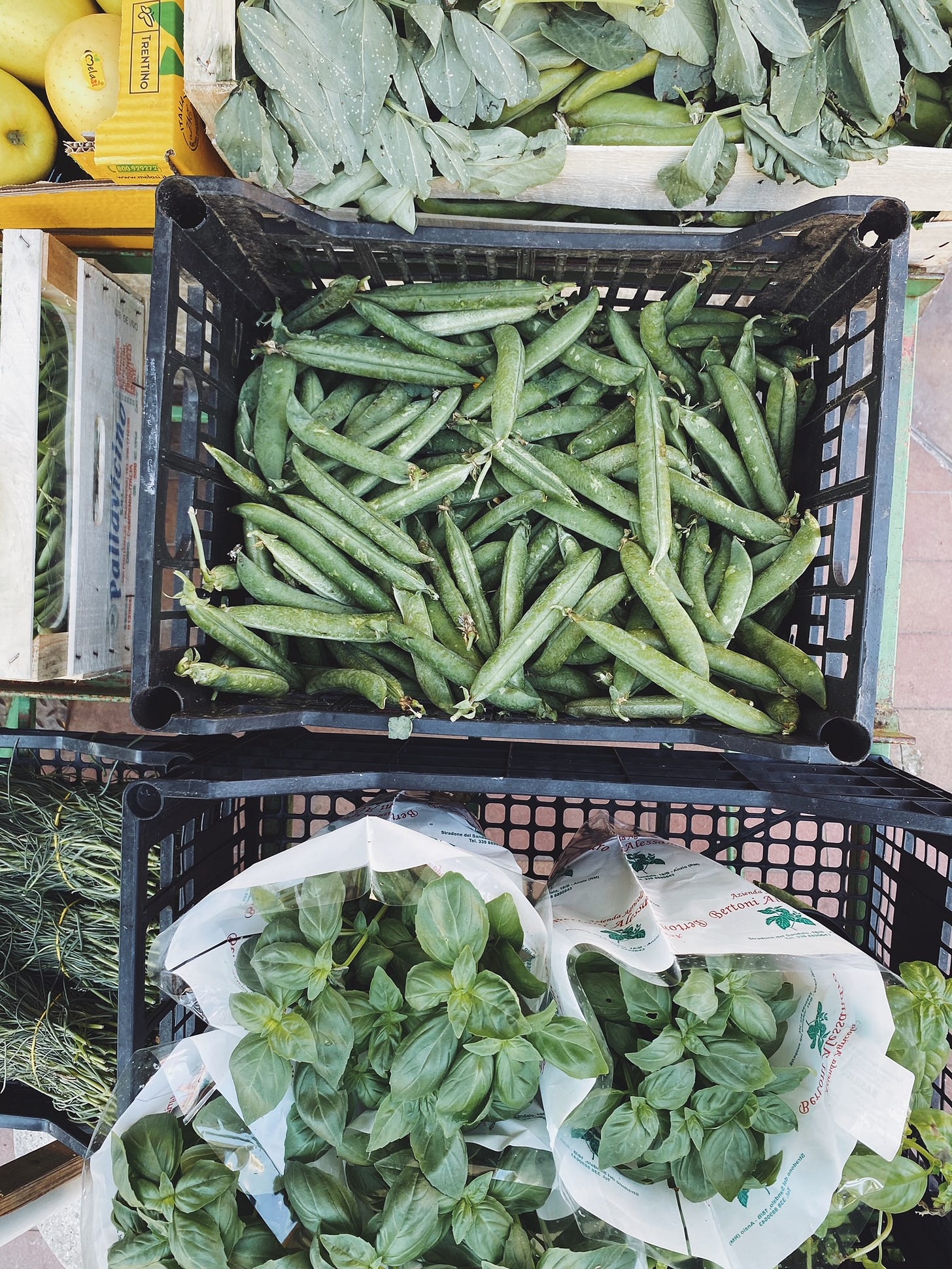
The herbs that I planted in the pots outside of the front door last June have grown back beautifully this year and the marjoram with its soft citrus floral notes and elegant oval leaves is looking incredibly lush. This prompted my original craving for this plate of pasta and my desire to share it with you.
The international perception of Italian cuisine can be homogenous in that it often lacks authenticity and regional identity. When most people think of Italian cooking, basil, parsley and oregano usually come to mind, followed by rosemary and sage. Herbs like bay leaf, lesser calamint aka mentuccia and marjoram (cousins in the mint family Lamiaceae) tend to be underdogs in the minds of the masses.
These are only a few examples of an array of aromatic herbs that give depth, uniqueness, authenticity and that je ne sais quoi that visitors find when they travel across borders into territories that give rise to traditional preparations. Fresh herbs like marjoram and the use of local and seasonal ingredients allow us to achieve “it doesn’t taste like this at home’’ levels without getting on a plane. If you aren’t already familiar with marjoram's fabulous herbaceous flavour, then I want you to be.
Marjoram reminds me of the 80’s and the stained pages of my mother’s puffy red plaid Better Homes and Gardens cookbook with its faded images of almost lacquered stuffed tomatoes. The black print recipes repeatedly cited marjoram which I had only ever seen unused in its expired form on dusty spice racks.
I came to know this ingredient in its fresh form with surprise and delight when I started eating and cooking la cucina Sabina. Known locally as la persa, and quite possibly referring to its disputed origins between Persia and North Africa, it is widely used across the Mediterranean.
In the ancient world, it was a symbol of happiness used for culinary and medicinal purposes in Greece and Rome. Marjoram originates in the royal genus of Origanum and is a cousin of oregano who also wears a flowering crown in the mint family. For this reason, it is often assumed that these perennial culinary herbs are the same or even interchangeable, but Origanum majorana brings a milder, smoother and more balanced profile. And it is because of its delicate and warm woodsy flavour that marjoram is best added at the end of cooking.
The plastic name marker that came with last year’s plant is just another example of how the classical culture of this peninsula is still reflected in Italy’s regional food traditions. For thousands of years, ingredients like marjoram have been used for sustenance and flavour and as a curative vehicle of nutrition, health and well-being.
The scent of marjoram is more delicate than that of oregano which is fresher and more pungent. Fresh or dried leaves are used: drying makes the aroma more intense. Its inimitable flavor enriches an infinite number of dishes: from simple tomato salads, to veal, lamb and chicken, to fish, omelettes, minestrone, carrots, cauliflower and mushrooms. Gastronomes recommend adding marjoram only at the last minutes of cooking, to better preserve the aroma.
The rest of the torn plastic ticket explains marjoram’s unique healing qualities to those who are interested. A carrier of Vitamin C with antispasmodic and purifying antiseptic properties, marjoram can be added to relaxing baths and teas to ease intestinal colic, sore throats and insomnia. Its anti-stress and anti-anxiety properties have calming and soothing effects that support courage, balance and strength.
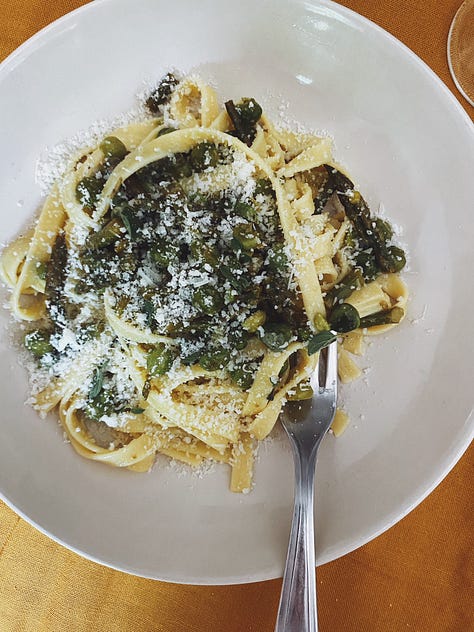
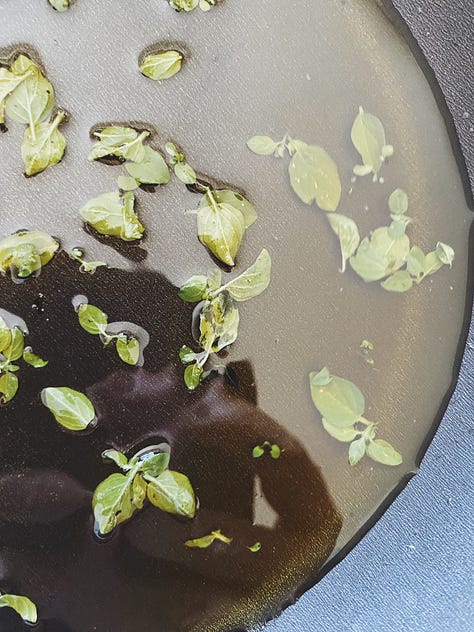
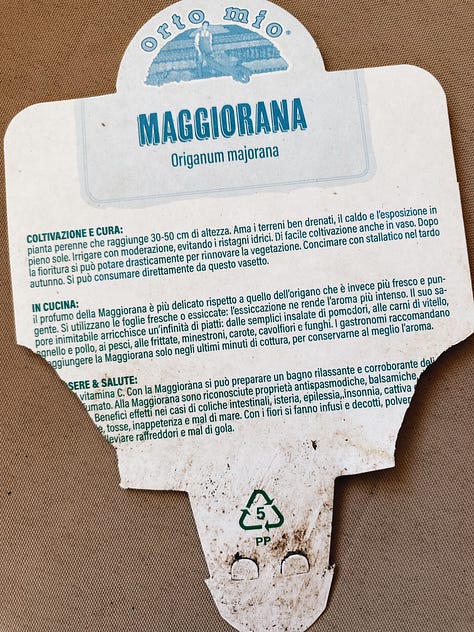
The Italian verb perdere means ‘to lose’. With employment calling Riccardo away from Italy for the past month, I have been required to meet the challenging task of parenting on my own with very little support (all hail single parents), and the situation has left me feeling slightly ‘persa’. Here I am called to ponder ‘the energetics of food’ and our subconscious and innate desire, knowing and craving for certain nutrients that bring balance and support to our current state of being. And with this, my overwhelming desire for marjoram during a month where I have sometimes found myself in an overwhelmed, anxious or stressful state makes sense. The healing properties of marjoram, not to mention the flavour, might appeal to you as well.
A week later I contemplated having another spin with the asparagus and the peas but as I predicted the fresh peas were nowhere to be found, and the stick-thin asparagus that I could get my hands on weren’t looking so fresh. This brought me back to my original craving, and I felt incredibly satisfied by this delicate plate of garden-fresh marjoram gently warmed in the prestigious olive oil of our Sabina, where I tossed and turned my thin ribbons of gluten-free tagliolini before covering it all in a generous dusting of snowy pecorino. The unexpected olfactory experience brought by the bouquet of this uncomplicated and easy-to-prepare dish is extremely pleasant and not as overwhelming as one might expect. It brought instant happiness.
Eating local and seasonal leaves the retrogusto of territory on our palates. What grows together goes together and what is growing right now is what our bodies need right now because as my late father-in-law once said, ‘nature is perfect’. Cravings are where desire and satisfaction intersect, and desire exists to help us fulfil what we are missing.
Hence the importance of not becoming distracted by the shiny possibilities that the various seasons of life can often dangle before you. Sometimes to be truly content we must stay focused, put our heads down, trust our guts and follow the winding path of our true cravings which will always lead us back to our original desire.
Although this recipe contains pecorino and black pepper, they are used differently than one would find in the popular dish of Cacio e Pepe. The olive oil and the marjoram are very much the heroes of this recipe. The finely grated cheese laced with freshly ground black pepper are added at the last moment as an ideal complement to these flavours for a creamy but light finish. This is a no-fail approach to a dish prepared for one.
Tagliolini with Marjoram and Pecorino
Tagliolini alla maggiorana e pecorino
V/VE/GF/LF
Serves 1
Ingredients:
100g fresh egg tagliolini, regular or gluten-free
4 fresh sprigs of marjoram
Sabina DOP Extra Virgin Olive Oil
5-10g Pecorino Romano or plant-based substitute
Sea salt + freshly ground black pepper
Method:
Bring a medium pot of water to a boil and add a generous pinch of salt.
Finely grate the cheese and add freshly ground black pepper to suit your preference.
Lightly coat the bottom of a small frying pan with olive oil. Gently warm the oil over low heat. Add the leaves from 3 sprigs to the oil and turn off the heat to allow them to infuse.
Cook the pasta al dente and reserve a shot of pasta water.
Add the cooked pasta to the frying pan and gently mix and toss over low heat adding a bit of cooking water to loosen if necessary. Sprinkle with the pecorino and black pepper, gently mix and garnish with the last sprig of fresh marjoram. Serve immediately.
Notes:
With its golden yellow colour and shades of green, Sabina DOP Extra Virgin Olive Oil tends to be soft and fruity with elegant vegetable notes ranging from sweet to slightly bitter, spicy, balanced and aromatic. Try to use an oil that has similar characteristics. You might look in your local Italian speciality shop if you are interested in acquiring a bottle. Extra virgin olive oil has a range of healing properties as part of the Mediterranean diet. It’s good for your heart, skin, gut and cholesterol levels.
A version of this recipe is suitable for vegetarians and vegans when using a plant-based cheese with a taste profile similar to that of pecorino.





